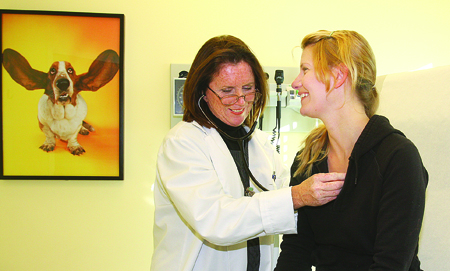Why primary care docs are hard to come by on the North Fork

If you’ve tried finding a family physician on the North Fork lately, you’ve probably had a hard time. There aren’t many on the North Fork, and many of those here aren’t taking new patients, so getting an appointment can be tough.
The economics of establishing and running a family practice are discouraging many young physicians. They opt instead to specialize, according to local experts.
The situation may change with health care reform, but currently, specialists, who are procedure-oriented, make money more reliably than primary care physicians can, according to Peconic Bay Medical Center president and CEO Andrew Mitchell.
Insurers and the government continue to erode payments to primary care practices, making their financial lives more difficult, he said. But if reform works as Mr. Mitchell thinks it will, primary care physicians will increasingly become “gatekeepers” who provide access to specialists — and that could improve their incomes, he said.
Several years ago, there was a “rapid decline” in the number of family physicians on the North Fork, Mr. Mitchell said. While that trend has slowed, there’s still a need for more primary care practitioners and more specialists, he said.
More doctors coming out of medical school facing hefty student loan payments can’t survive in a lone family practice, said Eastern Long Island Hospital president and CEO Paul Connor III.
“Long-established primary care doctors on the North Fork are getting older and their practices often aren’t accepting new patients,” Mr. Connor noted. Younger doctors aren’t stepping in to meet patient demand because they can’t afford to equip and staff independent offices when they’re burdened with debt for their medical school education, Mr. Connor said.
Younger doctors increasingly affiliate with an established practice because they can’t afford to set up their own offices, said Dr. Daniel Ferrara of Island Urgent Medical Care. That’s something of a boon for his group, which has locations in Riverhead, Mattituck and a number of Long Island communities farther west.
But even to staff his offices, he’s having to offer incentives. He’s lured doctors with promises of better schedules, vacations and an established office support staff. He even offers room and board when necessary to get doctors to work on the East End, he said.
“You can’t afford to do it on your own anymore,” Dr. Ferrara said of setting up a private practice.
For younger doctors without a practice, there’s also the option of taking a salaried job at a hospital. Eastern Long Island Hospital this month is hiring a team of hospitalists — doctors who will oversee patient care in the hospital to free up local primary care physicians with hospital-admitting privileges from that requirement. He declined to say how many.
Mr. Connor at ELIH said it’s costing the hospital to hire full-time staff doctors. He said eventually, however, they will yield income for the hospital if insurance company reimbursements for their services are adequate. Meanwhile, hiring them is a step he said he had to take because of the strains primary care physicians face trying to care for patients in the hospital.
They need to see as many patients as possible at their offices. Devoting a couple of hours a day to hospital rounds makes it difficult for them to earn enough money in their private practices, he said.
“The only way for us to do it is volume,” Dr. Ferrara said of general practice. He praised the hospitalist system as a way to make general practices viable, yet produce revenue for the hospital, and at the same time provide better patient care.
A private family physician can stop in briefly only once a day while the hospitalist, who has full access to all the patient’s digital medical records, is on site all day to oversee patient care, he said.
Hospitalists are only one way Peconic Bay Medical Center is helping primary care physicians, Mr. Mitchell said. He also contracts with primary care groups to provide support. It’s a financially integrated system that benefits both partners, Mr. Mitchell said.
The dearth of family physicians and the need for doctors to see patients more hours in the week has given rise to walk-in centers such as the one operated by Dr. Michael Catapano in Cutchogue. It is open seven days a week and he sees a lot of patients who otherwise would seek services in hospital emergency rooms for illnesses he can easily treat.
His contracts with insurers prohibit him from converting his walk-in patients to regular primary care patients, although he does have a few patients for whom he serves as primary care doctor.
“This kind of practice seems to thrive wherever you put it down in this country,” Dr. Catapano said of his walk-in services. Walk-in medical offices aren’t new, he added, noting that a friend with whom he served his residency 30 years ago opened such a practice then.
“It made sense back then and it makes sense now,” he said.
He, too, applauded the hospitalist approach being adopted by ELIH.
“It does make it better for a family physician who can focus on his office,” Dr. Catapano said.


